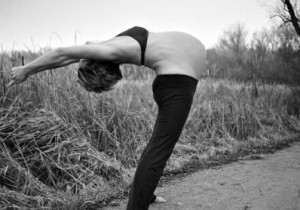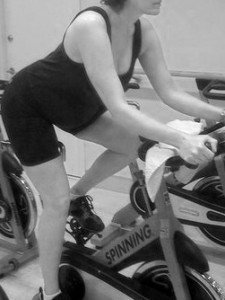One of my students recently forwarded me a link to a very pregnant yogini doing extremely advance yoga poses. She asked me my thoughts on this trend. I have to admit, this is something I have been noticing in social media and I am quite upset by the praise these women are getting for not adjusting their practices when pregnant. In fact, there seems to be a celebration of women who keep up with their old life and yoga practice or workout routine when weeks pregnant. Is this wrong?
In full disclosure, I was one of those women for my first pregnancy. (But after a 42 hour labor- I learned the errors of my ways for my second baby!) I was decked out in my “spin” clothes the day my labor started with my son. While my yoga practice shifted, I stubbornly continued much of my “pre-pregnancy” workout at the gym. I remember my spin instructor saying that while many of her pregnant students look great during their pregnancies, most of them ended up with a cesarean birth. At the time, I had not connected the cycling to causing overly tight pelvic floor muscles. I was convinced that would not be me. Fortunately, I avoided a c-section but only because I had a home birth. Had I been at a hospital, I would have been classified “failure to progress” due to the extremely slow and methodical labor. It took tremendous work and patience to realign a malpositioned baby during labor. Another student shared a similar story about her obsession with barre classes during her first pregnancy and wonder if this is why her 1st labor was so dysfunctional. She ended up having a cesarean and is hoping for a VBAC this time.
So what is it about certain classes and exercises that can make labor difficult and prove to be detrimental for the pregnant body? In terms of spin and barre, both these classes has the potential to create overly tight pelvic floor muscles and ligaments, torque pelvic and uterine ligaments and shorten the psoas muscle, all of which can lead to a malpostioned baby. This can make for a longer, harder labor and delivery. Birth functions best when the pelvic and supple and balanced allowing for the baby to find optimal fetal position. To those taking spin classes, I recommend stopping around 30 weeks. Past this point, due to the forward tilt of the pelvis and torso, there is an increased chance of significant strain and weakening to the abdominal muscles which can cause diastisis (abdominal separation).
While I had my own experience and knowledge in this topic, I wanted to add the thoughts and comments from one of the most knowledgeable people I know on this topic, Pamela Morrison, a physical therapist who specializes in women’s health. Here is what Morrison says about spinning, “Several of my patients continue spinning during the latter phases of pregnancy and have come in with “hard bodies” as opposed to soft and supple which is why the hormone relaxin is dominant…to soften the ligament, tendons, and muscles for ease of labor and delivery. This spinning in upright or off the bike requires excessive use of the pelvic floor to stabilize the core. Creating a tensing or tightening. Excessive biking also requires a lot of work to be done by the psoas muscles, one of the major hip flexors… also feeding into tightness.”
Many barre classes incorporate so much external rotation, that the deep rotator muscles can be overly tight and spasm and cause imbalance of the pelvic floor and sacroilliac joint. Morrison also states “The use of accessory hip rotators to strengthening pelvic floor muscles in the incontinent population is common. Thus, I agree that the during barre classes, if this technique is being used it could potentially overly strengthen the pelvic floor muscles. That being said, those that are experiencing incontinent episodes may benefit from this approach. However, too much of this may cause overuse and lead to tight, shortened pelvic floor muscles making labor and delivery more difficult.”
I am not saying never take these classes while pregnant, I am just advising to do them in moderation and taper off towards the end of pregnancy and find a class that promotes a healthy balance of pelvis. As a doula, having attended long labors and as a pregnant woman, having had a long labor, it is exhausting and recovery is very challenging. Set yourself up for success in how you prepare for labor and delivery. For my second pregnancy, I took a 180 degree turn in how I approached staying healthy and fit. My goal was to find balance in my body, mind and life and acceptance of my changing body. My desire for an easy labor outweighed my desire to retain a fitness lifestyle that was not conducive to the birth I wanted.
Heading back to the idea of yoginis practicing advanced poses. My biggest grievance with this is, it is sending the message that the yoga practice is only about the “ideal pose” and not about caring for the pregnant body and being responsible for a growing baby. No matter how advanced a practitioner is, all bodies experience hormonal, structural and balance changes that can leave the body more susceptible to injury.
Upon conception, the hormone relaxin is released into the blood stream. Relaxin is responsible for softening ligaments and tendons. Progesterone is also increased which relaxes smooth muscle and the increase of estrogen soften connective tissue. All of this is wonderful to allow the pregnant body to expand and facilitate the pelvis opening for birth, but can also be problematic. Pregnant women are more apt to overstretch due to the major hormonal changes. So a practitioner can easily go too deep in a posture without realizing it. Some of the most egregious displays of advanced poses during pregnancy are backbends and inversions. Deep backbends not only compress the already exaggerated lumbar curve, but pose the risk of overly lengthening and stretching the abdominal muscles and uterine wall which can possibly result in placental abruption, the placenta detaching from the uterine wall.

With advanced inversion late in pregnancy; even for the most advanced practitioner, there is an increased risk of falling out of the pose due to the growing belly changing the center of balance. If the intention is to encourage the baby head down, being upside down on a regular basis will not help. Furthermore, Morrison comments, “The inversion position would cause significant weight and tension on the linea alba potentially causing more propensity for stress- strain and separation. The only time this is an exception according to “spinning babies” website is when the mothers are attempting to get a breech positioned baby to turn. Gentle inversions are then used to create more space for the baby to move.”
I couldn’t resist adding this quote from a prenatal yoga student. It embodies the essence of resolving to a new reason and purpose for one’s yoga practice.
The way I practiced transformed into something I hadn’t anticipated. Something changes when you become responsible for the growth of a pure and innocent human being, that you eat healthy for the baby and you nurture yourself for the baby. One of those things included me doing yoga for what is now him, and rather than placing the importance on the potentially strenuous physicality of yoga, I did it to internalize, connect and feel peace. This included even just finding a quiet place to close my eyes, follow my breath, and do small and subtle physical movements throughout the week. When my mind was quiet, I could really listen to any of the needs of my pregnancy. ~Mibella, mother of Otis.
Think about why you are doing these classes or continuing a yoga practice that represents life before baby. Backbends, spin class, barre class will all be there post-baby. It will be a lot harder to get back to a pre-baby fitness or yoga level if you are healing major diastasis or pelvic floor issues. Embrace pregnancy as a time to slow down, deeply listen the needs of your baby and body and surrender to the transition of motherhood.


